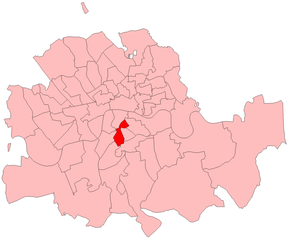Newington West (UK Parliament constituency)
| Newington West | |
|---|---|
|
Former Borough constituency for the House of Commons | |
| 1885–1918 | |
| Number of members | one |
| Replaced by | Southwark Central |
| Created from | Southwark |
Newington West was a parliamentary constituency in the Newington area of South London. It returned one Member of Parliament (MP) to the House of Commons of the Parliament of the United Kingdom, elected by the first past the post system.
History

Newington West in the Metropolitan Board of Works area, showing boundaries used from 1885 to 1918.
The constituency was created by the Redistribution of Seats Act 1885 for the 1885 general election. It was abolished for the 1918 general election, although the new constituency of Southwark Central had very similar boundaries.
Members of Parliament
| Election | Member[1] | Party[2] | |
|---|---|---|---|
| 1885 | Charles Wallwyn Radcliffe Cooke | Conservative | |
| 1892 | Cecil William Norton | Liberal | |
| 1916 by-election | James Daniel Gilbert | Liberal | |
| 1918 | constituency abolished | ||
Election results
| Election | Political result | Candidate | Party | Votes | % | ±% | ||
|---|---|---|---|---|---|---|---|---|
| General election 1885 [2] New seat Electorate: 6,377 Turnout: 5,014 (78.6%) N/A | Conservative win Majority: 645 (12.8%) N/A | C. W. Radcliffe Cooke | Conservative | 2,419 | 48.2 | N/A | ||
| John Seymour Keay | Liberal | 1,774 | 35.4 | N/A | ||||
| Sir William McArthur[3] | Independent Liberal | 821 | 16.4 | N/A | ||||
| General election 1886 [2] Electorate: 6,377 Turnout: 4,502 (70.8%) −7.8 | Conservative hold Majority: 382 (8.4%) −4.4 Swing: 2.2% from Con to Lib | C. W. Radcliffe Cooke | Conservative | 2,447 | 54.2 | +6.0 | ||
| Joseph Firth Bottomley Firth | Liberal | 2,065 | 45.8 | +10.4 | ||||
| General election 1892 [2] Electorate: 7,579 Turnout: 5,749 (75.9%) +5.1 | Liberal gain from Conservative Majority: 1,093 (19.0%) Swing: 13.7% from Con to Lib | Cecil Norton | Liberal | 3,421 | 59.5 | +13.7 | ||
| George William Tallents | Conservative | 2,238 | 40.5 | −13.7 | ||||
| General election 1895 [2] Electorate: 7,971 Turnout: 5,978 (75.1%) −0.8 | Liberal hold Majority: 450 (7.6%) −11.4 Swing: 5.7% from Lib to Con | Cecil Norton | Liberal | 3,219 | 53.8 | −5.7 | ||
| George William Tallents | Conservative | 2,769 | 46.2 | 5.7 | ||||
| General election 1900 [2] Electorate: 8,491 Turnout: 5,962 (70.2%) −4.9 | Liberal hold Majority: 1,156 (19.4%) +11.8 Swing: 5.9% from Con to Lib | Cecil Norton | Liberal | 3,559 | 59.7 | +5.9 | ||
| Francis Ignatius Ricarde-Seaver | Conservative | 2,403 | 40.3 | −5.9 | ||||
| General election 1906 [2] Electorate: 8,995 Turnout: 6,871 (76.4%) +6.2 | Liberal hold Majority: 2,021 (29.4%) +10.0 Swing: 5.0% from Con to Lib | Cecil Norton | Liberal | 4,446 | 64.7 | +5.0 | ||
| Ralph Emanuel Belilios[4] | Conservative | 2,425 | 35.3 | −5.0 | ||||
| General election January 1910 [2] Electorate: 9,635 Turnout: 8,288 (86.0%) +9.6 | Liberal hold Majority: 412 (5.0%) −24.4 Swing: 12.2% from Lib to Con | Cecil Norton | Liberal | 4,350 | 52.5 | −12.2 | ||
| Warwick Brookes | Conservative | 3,938 | 47.5 | +12.2 | ||||
| General election December 1910 [2] Electorate: 9,635 Turnout: 7,536 (78.2%) −7.8 | Liberal hold Majority: 540 (7.2%) +2.2 Swing: 1.1% from Con to Lib | Cecil Norton | Liberal | 4,038 | 53.6 | +1.1 | ||
| Warwick Brookes | Conservative | 3,498 | 46.4 | −1.1 | ||||
| By-election January 1916 [2] Norton elevated to the peerage Electorate: 9,814 Turnout: 3,433 (35.0%) −43.2 | Liberal hold Majority: 1,859 (54.2%) +47.0 | James Daniel Gilbert | Liberal | 1,646 | 77.1 | +23.5 | ||
| Joseph J. Terrett | Independent Labour | 787 | 22.9 | N/A | ||||
Notes and references
- ↑ Leigh Rayment's Historical List of MPs – Constituencies beginning with "N" (part 1)
- ↑ 2.0 2.1 2.2 2.3 2.4 2.5 2.6 2.7 2.8 2.9 Craig, F. W. S. (1983) [1969]. British parliamentary election results 1918–1949 (3rd ed.). Chichester: Parliamentary Research Services. p. 37. ISBN 0-900178-06-X.
- ↑ Sir William McArthur had been MP for Lambeth from 1868 until that constituency was abolished for the 1885 election
- ↑ Beliliois unsuccessfully contested Newington Walworth at the elections in January 1910 and December 1910
- Debrett’s Illustrated Heraldic and Biographical House of Commons and the Judicial Bench 1886
- Debrett’s House of Commons and the Judicial Bench 1901
- Debrett’s House of Commons and the Judicial Bench 1918